Nine exercises to relieve foot and ankle pain
What causes foot and ankle pain?
A number of different things can cause foot and ankle pain. Around 1 in 5 middle-aged or older people suffer from it, and women are particularly affected. The most common causes involve the soft tissues of the foot and ankle:
- Plantar fasciitis: this usually causes pain in your heel and along the arch of the foot. Plantar fasciitis occurs when the soft tissue on the underside of the foot (the plantar fascia) becomes inflamed. The pain is often worse after being inactive or first thing in the morning
- Achilles tendonitis: this causes pain at the back of the ankle when the Achilles tendon, which connects the calf muscles to the heel bone, becomes irritated. It can be caused by overuse, often when you start a new type of exercise or if the amount you exercise is increased
- Ankle sprains: these occur when the ligaments (the soft tissues connecting the bones of the foot) are damaged due to an injury. There will often be pain around the ankle and bruising or swelling, as well as reduced movement
What can I do to relieve my foot and ankle pain?
Soft tissue takes time to heal, but there are a number of things you can do to help speed up the process:
- Exercises help to relieve pain by loosening up the soft tissues in your feet. Tightness in the Achilles tendon can often have a knock-on effect on the plantar fascia, so these areas are particularly important to target. Read on for a list of suggested exercises to ease your pain
- Resting your feet wherever possible by not running, walking or standing for too long can help to avoid any more inflammation
- Wearing comfortable shoes with good arch support will also reduce the strain on your feet
- Painkillers such as paracetamol and ibuprofen can help to control the pain. Ibuprofen is also an anti-inflammatory meaning it will help to relieve any swelling. Taking these as tablets or using anti-inflammatory creams can both be helpful. Remember to not take more than the recommended dose
- Ice packs pressed against the bottom of the foot can help to reduce swelling. Do not apply ice directly to the skin; instead, try wrapping the pack in a tea towel
Which exercises can I use?
Regular, gentle exercises can help loosen up muscles and tendons to get your foot moving normally again and reduce pain. Research has shown that exercises are effective at reducing symptoms in plantar fasciitis, Achilles tendonitis and ankle sprains.
Frequency is important to make the exercises as effective as possible, so aim to do your chosen exercises three times a day. You can increase the frequency and the number of repetitions over time but keep the intensity low.
Below are nine exercises to relieve foot and ankle pain. These exercises can be used in any combination or on their own, so choose the ones that work best for you. Exercises 1-7 can be done seated, while 8 and 9 are done standing up:
1 – Achilles tendon and plantar fascia stretch
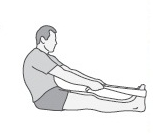
This exercise is first on the list as it soothes two of the most painful areas: the Achilles tendon and the plantar fascia. To begin, loop a towel around the ball of your foot and pull back towards your body with the knee kept straight. Hold for 30 seconds for each foot.
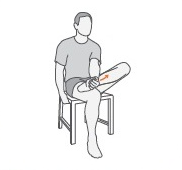 2 – Sitting plantar fascia stretch
2 – Sitting plantar fascia stretch
Cross your foot over the opposite knee. Hold the base of the toes and gently pull back until you feel a stretch along the underside of your foot. Hold for 15-20 seconds per repetition. Repeat 3 times on each foot.
3 – Towel pickup
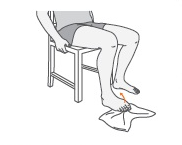
Place a towel on the floor in front of your chair. With your heel on the ground, pick up the towel by grabbing it with your toes. Repeat 10-20 times. This exercise can be improved by adding a small weight to the towel.
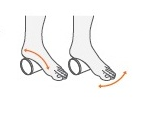 4 – Plantar fascia stretch
4 – Plantar fascia stretch
Put your foot on top of a rounded object (eg. a can of soup). With light pressure, roll the arch of your foot back and forth over the object for a few minutes.
5 – Seated foot and heel raise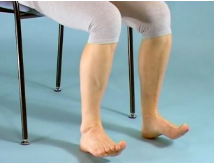
Begin with your feet flat on the floor. Raise both heels off the floor and hold for a few seconds before placing your heels back on the floor. Then raise your toes off the floor and hold for a few seconds before returning them to the floor. Repeat 5 times.
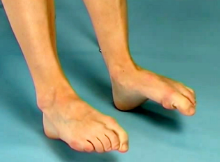 6 – Toe bend
6 – Toe bend
Place your heels on the floor with your toes pointing in the air in front of you. Bend your toes downwards and hold for a few seconds, then relax. Next, bend your toes upwards and hold for a few seconds before relaxing. Repeat 5 times.
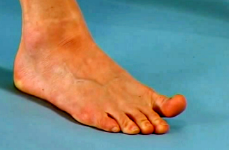
7 – Big toe lift and hold
With your feet on the floor, lift only your big toe whilst keeping the other toes on the floor. Hold this for a few seconds and relax. Repeat 5 times.
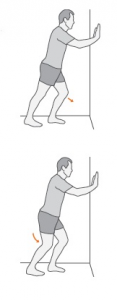
8 – Standing calf stretch
Stand facing a wall and place both hands on the wall in front of you. Put one foot in front of the other with the front foot about 30cm away from the wall. Keep the back knee straight with your back heel flat on the floor. Slowly bend your front knee until you can feel a stretch in the calf of your back leg. Relax and repeat 10 times. This exercise can also be done with the back knee slightly bent for a milder stretch.
9 – Deep calf stretch
Stand on a step with your heel hanging off the edge. You may want to hold onto something for support. Allow your heels to drop towards the floor and feel a stretch in the calf muscles and Achilles tendon. Hold for 20 seconds. Repeat 3 times.
Remember to stop doing these exercises if they cause new pain or make your symptoms worse.
In summary
Foot and ankle pain can occur for a number of reasons but can be relieved by gentle exercise and stretching. Choose a variety of the exercises listed above and aim to do them at least three times a day. Repeat the exercises daily, and try to rest your feet as much as possible in between.
Exercises should begin to relieve your foot and ankle pain within 2 weeks and recovery should take around 4-6 weeks in total5. Wear the right shoes, and use painkillers, anti-inflammatories and ice packs to speed up the healing process. If you continue to experience pain, you should speak to your GP.
Date: 22/02/2019
By: gpittson


 2 – Sitting plantar fascia stretch
2 – Sitting plantar fascia stretch
 4 – Plantar fascia stretch
4 – Plantar fascia stretch
 6 – Toe bend
6 – Toe bend
